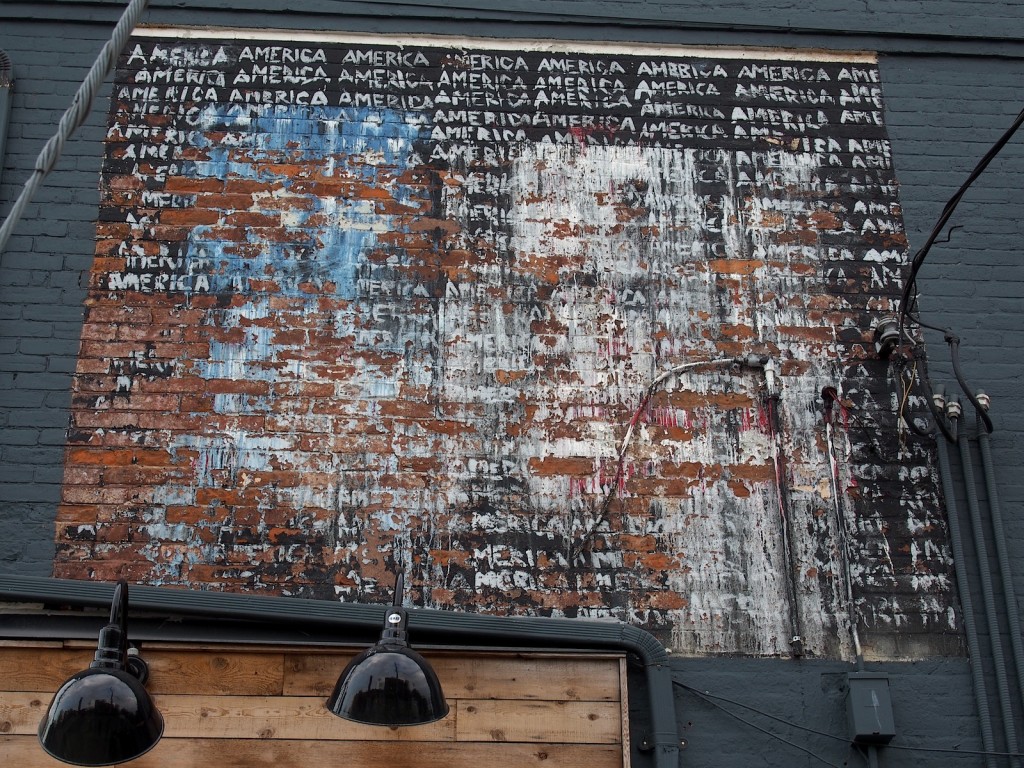Every time I arrive here I have the same feeling of pleasant disorientation, because Toronto is so obviously one of the great cities of the North American continent, yet this is also most definitely not America What makes it different is damned hard to pin down, and the best I can do now is to say that it its something hanging in the air that makes me feel relaxed and sets me thinking. So, when I stumbled upon this mural by Toronto artist Steve Driscoll on the side of a restaurant on College Street I was totally fascinated. It is the first work of art I’ve encountered that takes the Canadian-American relationship as its theme, and it does so in a way that I’d need to write an entire essay to describe properly. To see Steve Driscoll’s recent work go to:
This strikes me as exactly right, not least because historically the Canadian-American relationship has been complex and continually shifting. To be frank, the closer the two nations came to being in political lockstep the worse I found that relationship, because it always seemed to mean some Canadian politicians were blindly following the then American administration, and the more successfully Canada developed and articulated an alternative position the better I found that. Of course, the border between the two is just a line on the map and therefore its position is arbitrary. Students of Canadian and/or British colonial history will know that it has been moved several times. However, if you go to Google Earth and look at that border out West, then you will see it clearly from Outer Space due to the contrasting treatment of the land on the USA side (you can see the 1 mile by 1 mile grid that Jefferson and Co. threw over their section of the continent more than 200 years ago) and Canada side (some linear roads, but no grid). What does this say? You don’t have to do things the American way, and it isn’t always the best way. Sadly, that’s something many intelligent Americans don’t accept, because of a tendency by them to support the status quo they see as economically beneficial to them. This has lead to to long-term problems like racism or the destructive effect of US agricultural policy being ignored with major consequences.
Yesterday, I attended the Terroir 2015 conference (the twitter hashtag is #Terroir9, for those interested to get an overview of what happened) here in Toronto where I spoke, but much more importantly listened. The very first presentation of the day, by Ian Brown, Roving Reporter for the Globe and Mail – “Canada’s rational newspaper” – here in the city, was worth the journey here and the serious state of burn out I experienced last night. Early in the summer of 2013 Ian Brown set off on a journey of culinary discovery traveling across Canada coast to coast to find out what people actually eat. He did this without a list of top restaurants to test or fast food joints to check out, and with no political agenda of any kind, although he was clearly intensely aware of the economics and social context of all that encountered. He didn’t avoid saying what tasted good and what didn’t, for example, daring to say that some First Nation (Canadian for the native inhabitants of this land) food was horrible, but in the final analysis he undertook this epic journey, “as an empty vessel”. To read his stories go to:
http://www.theglobeandmail.com/authors/ian-brown
Not only was the way he described things he ate, like a humburger in a nudist restaurant (called The Naked Lunch – had they read Edgar Burroughs book of the same name?), very finny and extremely perceptive, he came to some inspiring conclusions of which the following are the most important: “anything that might qualify as the national dish has been eaten by the First Nations for millennia,” and “there’s something more important than judgement, and that’s gratitude for having been fed, or for having someone to cook for.” Thanks Steven Driscoll and Ian Brown for feeding me with your distinctively Canadian inspiration. Now it’s time to taste some wine and seek liquid inspiration!


![120114_riesling_global_RZ [1600x1200]](http://www.stuartpigott.de/wp-content/uploads/2015/05/120114_riesling_global_RZ-1600x12005.jpg)